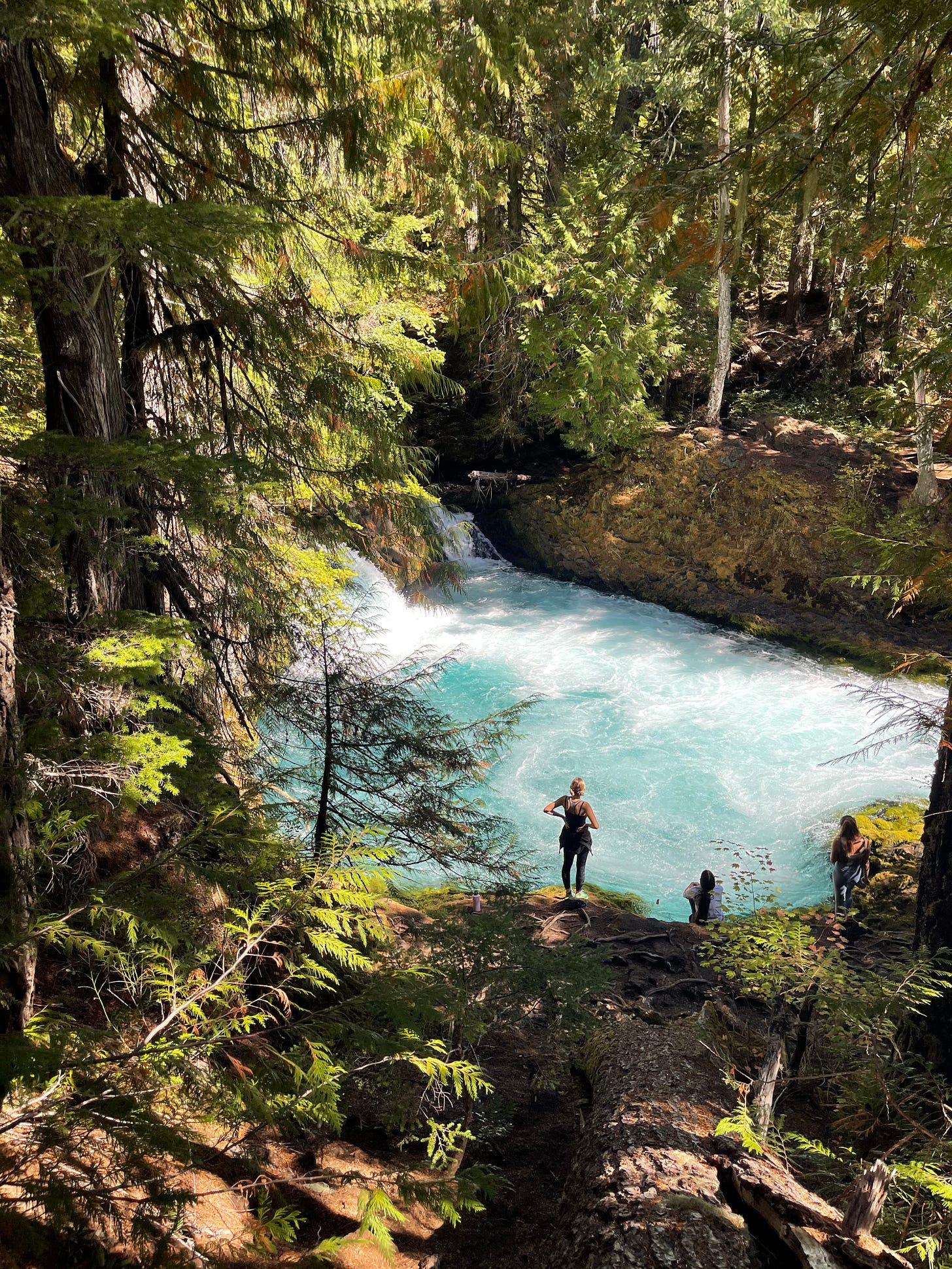Recently, Joe Rogan shared an Instagram post with a photo of an elk leg. The caption was hysterical.
There’s a few obvious problems with his caption. First, the idea that his friend was never notified of this wolf reintroduction is implausible given the tremendous amount of press and public information campaigns for wolf reintroduction in the state.
Second, the idea of wolves being bad guys in every fairy tale is one which I’ve covered on this Substack before. The vilification of wolves in Western narratives is one of the West’s most bizarre myths. Countless nature writers have described the way wolves operate as a shadow for people to project onto. Wolf attacks are so infrequent that there have been 2 fatalities in North America in the last 100 years. In reality, wolves are afraid of humans and confrontations are incredibly rare.
Rogan’s claim that wolves will “eat anything they can” is factually untrue and I cannot see any other reason to say it except being sensationalist. You do not have to be a scientist or a researcher to know that wolves do not “eat anything they can” but have specific hunting behaviors. Ecosystems with an abundance of wolves do not see the extinction of other animals. Rather, wolves are one of many species that can increase biodiversity in an ecosystem.
But the funniest part of the caption is that it is literally just a picture of an elk’s leg. Joe is feigning concern for livestock, but the picture in the post is of an elk leg which is exactly what the wolf is supposed to be eating. Imagine getting worked up and ranting about being scared that bees will kill your dog, but the picture you post to rationalize that fear is a bee on a flower. (if that seems an unfair analogy, consider that bees kill tens of thousands of times more Americans than wolves.)
Rogan’s post is representative of decades of playing wolf by farmers and ranchers. While I am certainly not against these professions (having farmers in my own family), ranchers and farmers have a long history of lying about wolf attacks. Statistics on livestock deaths by wolves show that the number is extremely low. Most estimates suggest that wolves are responsible for less than 1% of livestock deaths.
And to really drive home the hysterical nature of such posts, Colorado, like other states, offers full compensation for livestock deaths in the case of a wolf killing or injuring livestock. So, even if Joe Rogan’s buddy had shared a photo of with his own livestock in it instead of an elk, he would have been fully reimbursed.
So, if money is not the issue (full reimbursement), and care for the animal is not the issue (cattle will be used and killed by the human just as for the wolf), what is driving such sensationalist posts about wolves?
I want to compare the attitude of Rogan and his friends to my 11 y/o students at nature school and a recent class where we found a dead rattlesnake.
I teach several classes each week with young students in nature parks. One boy that I teach (we’ll call him Ty) got bit by a rattlesnake in a class. He survived, but not without tremendous pain and a long stay at the hospital.
I began teaching Ty in 2024, a year or so after the bite and he told me all about his experience. It was bad enough that he blacked out from pain multiple times. He couldn’t hear or understand what was going on around him but remembers occasional phrases uttered by the adults rushing him to the hospital. He was given the anti-venom and stayed at the hospital for what felt like forever. Even after receiving the anti-venom and going home, his body took time to recover.
So you might expect a similar reaction from Ty as the hysterics from Rogan and his ranching buddy, right? Well, you’d be wrong.
Ty’s favorite animal is now a rattlesnake. He feels a deep connection with them after his encounter. Another student commented on Ty’s connection by telling me Ty has a spiritual connection with them now that he has shared his blood with one.
Ty’s experience is what made it such an eventful day when we found a young rattlesnake on a hike a couple of weeks ago. On a moderately challenging hike, our group stopped after one student shouted that he found a snake. Sure enough, it was a rattlesnake that was too young to even be able to rattle his tail. We spent about 15 minutes watching the snake soak up the sun while we shared our knowledge of the species.
Rattlesnakes, we always say, are one of the most polite species of snakes. They are not aggressive and they like to warn people with noise so they can avoid a confrontation. People typically get bit when they do not notice the snake and step on them or when they try to handle them.
As an outdoor educator, rattlesnakes are by far the most common snake that I see. Last Friday for example, our group found 3 of them within an hour. Although we teach our students how to safely avoid them, students understand their behavior and are able to observe them from a distance.
So, after a while, our group went on its way to our destination. We found some caves, found a coyote den, had lunch, and turned back. While we were on the way back, we decided to look for the little rattler that we had passed. Unfortunately, we found it crushed, bleeding, and unable to turn right side up. He was slowly dying. In the short time that he had left it and come back, someone in the park had smashed the snake.
Our students were distraught. Many were angry and expressed wanting to retaliate against whoever had hurt the snake. Others cried. The other instructors and I talked to the students about how other people behave towards animals.
It was a really moving experience for us as instructors. The students in our class had become so familiar with rattlesnakes that they saw no reason to hurt one. They couldn’t quite grasp why anybody would want to. They pleaded for us to try and save the snake, but we told them he was too far gone. We decided to move on but the student who had previously been bit asked to stay behind and give the snake a funeral. We split so some could stay and process the event a bit further, while others could move on and feel more calm.
Our mood was impacted by the death of the snake for the rest of the class. And it’s not as if we do not experience death on our hikes. Even that day, we had seen a coyote carcass fresh enough to have all of its fur. But this snake death was different. We all understood that he was small and vulnerable. We also understood that he was killed out of malice, rather than survival. It was our students’ capacity to stay safe around these venomous snakes that allowed them to see the snake for what it was: small, young, and unaggressive.
So Rogan’s and his buddies are crying wolf on the internet, but they have not been attacked by wolves, nor has their cattle. Meanwhile, one of my 11 y/o students was bitten by a venomous snake and advocates for coexistence with this same species. Even after his potentially fatal bite, he was moved to tears by the killing of one during our class.
Their response to seeing the crushed rattlesnake was the most expressive I have ever seen this group. And the students were very vocal about their feelings. Some students said they would rather the rattlesnakes be able to live even if it meant an inconvenience to them. Ty himself doesn’t mind admitting that he was bit because he encroached on the snake’s space and made it feel threatened.
Our students definitely aren’t fearless. They understand the danger that these creatures pose, but have the knowledge and capacity to keep themselves safe around them. These students understand that rattlesnakes know humans can kill them and that rattlesnakes can kill humans. And yet, they admire them and want them to live and thrive. I would simply refer to this as respect.
Ecopsychologists like Bill Plotkin rightly see this basic respect for non-human life as a foundational milestone of human development that has been lost to Western cultures. How interesting then that students are able to easily establish this kind of mutual respect for other life at such a young age but so many adults cannot. I believe that their response isn’t exceptional or mature for their age. Instead, it is a very age appropriate response that is a part of healthy human development.
We can see the opposite of respect in the feeling of entitlement.
Why do so many people get so hysterical about wolves? Why do people endorse the eradication of an entire species out of the possibility that it may inconvenience them?
Clearly, most people don’t. There is a growing amount of research that suggests that most people have an innate appreciation for wild landscapes and feel grief over the extinction of species even when they’ve never encountered the species. Findings like these increase every day.
But if you look closely, there are plenty of spaces where the fear of life thrives. And people’s behavior toward wildlife is not just about their relationship to wildlife. It is completely intertwined with their relationship with themselves. The biophobia of the kind we see in so many Americans emerges from deep feelings of entitlement, resentment, impotency, and a smallness projected outwards in fits of violence or control.
I remember reading William Kitterage’s account of his grandpa luring birds in to kill them. He shot each bird that came to feed on his property with a shotgun. When Kitterage asked his grandpa why he did it, the response was “because they’re mine.”
This story always stuck with me because it is a unabashed confession that the eradication of species on one’s land is a sense of entitlement.
The fear of life and the desire to control it are symptoms of a person who is disconnected from themselves. Repressed personalities. Stifled dreams. Impotence. Being overindulged and lacking appropriate boundaries.
The kind of culture that fears the existence of wolves is the kind that cannot face itself and must project its shadow outwards onto others. Everything they see in the wolf is what they are afraid to address in themselves.
One comment said “Dang right Joe. Wolves eat everything in their path and will decimate the west if we let them.”
You can see the projection in these comments. The very people who say there is no room for wildlife in an entire state, even if all losses are reimbursed is the kind of person who eats everything in their path and will decimate the west if we let them.
My students are brave enough to defend a world full of wild creatures even when it comes with a little pain and inconvenience. Already at a young age, they are learning to care about things outside of themselves. To nurture the life around them which develops strong character.
As always, I’ll end by suggesting that so much of our disconnection stems from our loss of ancestral rites of passage and social technologies. We need passages into adulthood, initiations into roles in our community, and immersions into spaces that are more-than-human.





